The heart of America pulses strongly in Windy City, where history and contemporary creativity coexist harmoniously. Chicago, a thriving city perched along Lake Michigan’s beaches, is home to several famous landmarks that have withstood the test of time and continue to enthrall tourists worldwide.
Chicago provides many must-see sites highlighting the city’s rich legacy and dynamic character, from architectural masterpieces to cultural gems and natural wonders. Whether you’re a history buff, an art expert, or just an inquisitive visitor, these 15 landmarks Of Chicago will leave you in amazement and compelled to discover this magnificent city’s hidden corners.
Page Contents,:
Must Visit Landmarks in Chicago
- John Hancock Building
- Millennium Park And Cloud Gate
- Chicago River And Riverwalk
- Navy Pier
- Chicago Museum Of Science And Industry
- Chicago Water Tower
- Art Institute of Chicago
- Willis Tower (formerly Sears Tower)
1. John Hancock Building: Landmarks in Chicago
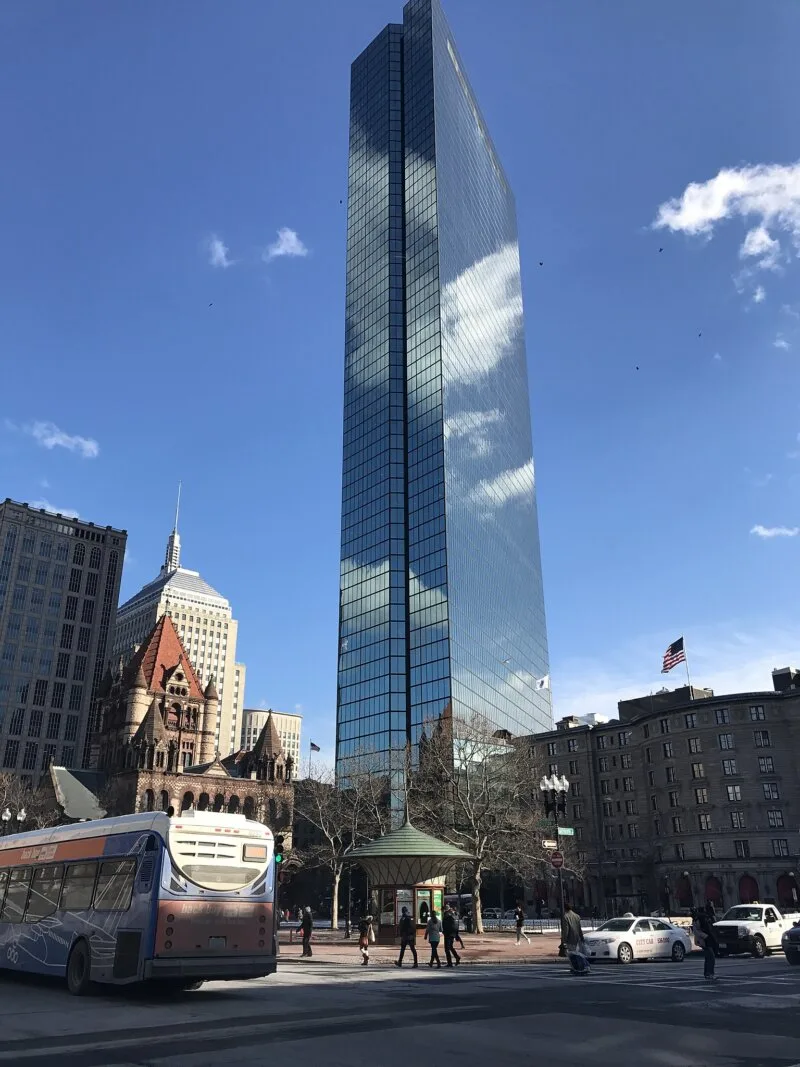 Source / License: Jp16103/CC BY-SA 4.0
Source / License: Jp16103/CC BY-SA 4.0Experience one of the Chicago landmarks list energetic spirit by visiting the renowned Hancock Building, a stunning structure with 100 stories and a 1,128-foot height. This iconic skyscraper, known as Big John, is situated at 875 North Michigan Avenue and represents Chicago’s spirit of innovation.
The Hancock Building epitomizes the vibrant and eclectic nature of the city with its blend of residential units, retail outlets, corporate offices, hotels, culinary locations, and cultural institutions.
The John Hancock Building, a masterpiece of architecture that dominates the famous Chicago skyline, has come to represent the rich heritage and creative energy of the Windy City. This famous monument enthralls tourists and residents with its elegant design, lofty height, and stunning vistas.
It is also known as 875 North Michigan Avenue and is a unique example of the engineering and structural brilliance of Skidmore, Owings & Merrill. This 100-story skyscraper, finished in 1969, rapidly represented development and modernism.
It was Chicago’s highest skyscraper until 1973, when the Sears Tower (now Willis Tower) overtook it, rising 1,128 feet (343 meters) above the busy city streets.
Suppose you want to extend your stay in Chicago and get a budget-friendly experience. Explore some great tour deals, which include the John Hancock Building as one of the tour packages to explore and hotel recommendations near the site.
2. Millennium Park And Cloud Gate
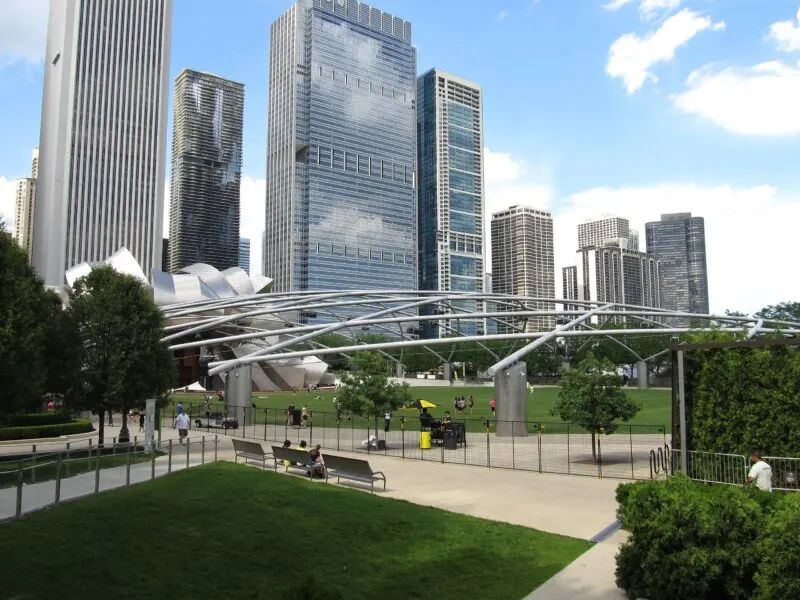 Source / License: Ken Lund/CC BY-SA 4.0
Source / License: Ken Lund/CC BY-SA 4.0Discover the well-known Cloudgate, often known as “The Bean,” a stunning British sculpture created by Anish Kapoor and located in Chicago’s Millennium Park. It is one of Chicago’s famous landmarks.
The alluring mirrored surface provides visitors with engaging interactive experiences that encourage investigation from all sides.
The Bean, a 110-pound structure that dominates the energetic Millennium Park in Chicago’s Loop area of Illinois, weighs 110 pounds. Discover this creative masterpiece’s charm and embrace the magical pleasures it offers.
The creation of Millennium Park, which debuted in 2004, was a groundbreaking initiative that transformed the urban environment and breathed new life into the city’s core. This enormous 24.5-acre park, created to celebrate the new millennium, is a tribute to Chicago’s commitment to embracing the future while honoring its rich history and architectural success.
Cloud Gate is located in the center of Millennium Park and serves as a representation of contemporary innovation. This intriguing sculpture was made by the brilliant British artist Anish Kapoor and skillfully combines human interaction, art, and technology. Modern engineering methods and cutting-edge materials were used in the 2006 building of Cloud Gate to create a masterpiece that astounds viewers.
Find the best deals for tour packages in all famous Chicago landmarks, and you will surely love it, there was more than just that because there was also Lincoln Park Zoo. Also, when you need a nearby place to stay from Millenium Park, find the nearest hotel recommendations here.
3. Chicago River And Riverwalk Landmarks in Chicago You Should Visit in 2023
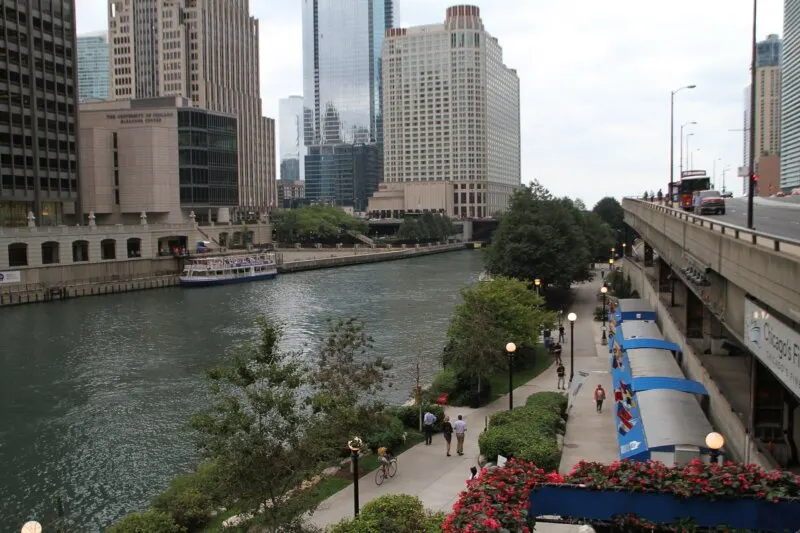 Source / License: HaSt/CC BY-SA 4.0
Source / License: HaSt/CC BY-SA 4.0Take a picturesque river trip to fully appreciate its splendor and get a bird’s eye view of the city’s architectural wonders. Alternatively, stroll along the alluring riverwalk, where you may enjoy a distinctive perspective while savoring the quaint ambiance of cafes, restaurants, and tranquil park areas.
After your excursions, relax and recover in this exquisite hideaway to guarantee the ideal balance of exploration and peace.
It is only possible to discuss the Chicago River as a famous landmark in Chicago by noting its magnificent architecture. Towering towers line the riverbanks, exhibiting a magnificent fusion of ancient ruins and cutting-edge works of art.
The river is one of Chicago’s landmarks, providing a prime viewing location for Chicago’s impressive architectural achievements, from the iconic Wrigley Building and Tribune Tower to the modern Trump International Hotel and Tower.
The Chicago River and Riverwalk have developed into a culture center, hosting various events and activities annually. This picturesque city area offers a stage for creativity to bloom, hosting everything from art exhibits to live music performances.
The Riverwalk is now a well-liked location for al fresco dining, providing a pleasant gastronomic experience and scenic vistas.
These tour packages include the Chicago River, with different accommodations nearby that you can enjoy with your family.
4. Navy Pier
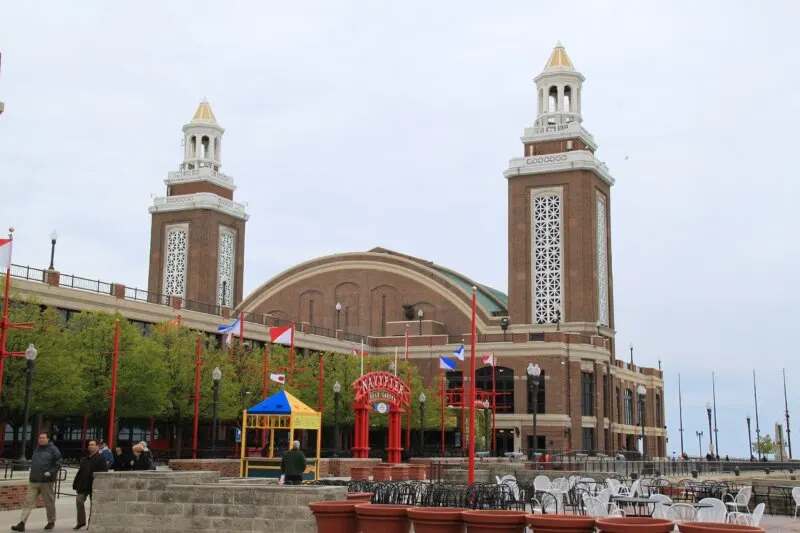 Source / License: Shaylaj/CC BY-SA 3.0
Source / License: Shaylaj/CC BY-SA 3.0For any visitor to Chicago, Navy Pier is a must-see monument and an iconic Chicago landmark. This busy pier has something to offer everyone, thanks to its user-friendly design and selection of activities.
The Pier has events and festivals that draw people of all ages throughout the year, offering everything from shopping to cultural attractions.
The idea for a Navy dock first emerged around the turn of the 20th century as a municipal dock for shipping and leisure activities. Over the years, it has seen several alterations, turning into the vibrant entertainment area we see today.
Originally known as Municipal Pier No. 2, it was eventually renamed Navy Pier in honor of the naval servicemen who trained there during World War II.
A flourishing center for culture and entertainment, Navy Pier offers an excellent selection of points of interest. The Pier offers visitors of all ages various attractions, from top-notch theaters and museums to exciting amusement rides and stores.
A few cultural treasures housed within its lively venues are the acclaimed Chicago Shakespeare Theater, the interactive Chicago Children’s Museum, and the mesmerizing Chicago IMAX theater.
Navy Pier’s unparalleled location along Lake Michigan is one of its distinguishing qualities. The Pier provides a beautiful backdrop for strolls, boat rides, and panorama photography with its spectacular views of the lake and the city skyline.
Visitors are encouraged to stroll along its expansive promenade to enjoy the tranquility of the lake and the beauty of the surroundings.
5. Chicago Museum Of Science And Industry
 Source / License: GualdimG/CC BY-SA 4.0
Source / License: GualdimG/CC BY-SA 4.0With its massive collection of over three million items, the Museum of Science and Industry is a powerhouse on the international stage and a famous landmark in Chicago. This prestigious institution has 14 ongoing exhibits that showcase amazing sights, including a coal mine, a German submarine, and a captivating mirror maze.
Visitors may expect a dynamic, ever-evolving experience at the museum in addition to the permanent exhibits, rotating exhibitions, nearby Lincoln Park Zoo, and temporary displays.
The Chicago Museum of Science and Industry has a colorful heritage that goes back to the Century of Progress Exposition, a World’s Fair in 1933–1934. The structure was initially intended to be a temporary exhibit, but because of its magnificence and the public’s enthusiastic response, it was preserved as a permanent institution.
As the largest science museum in the Western Hemisphere today, the institution presents ground-breaking displays that pique interest and awe.
The museum’s collection includes over three million objects from a wide spectrum of scientific and technological marvels, a veritable gold mine. Visitors can immerse themselves in various exhibitions that provide a view into scientific achievements’ history, present, and future, ranging from aviation and space exploration to energy, transportation, and human health.
The German submarine U-505, a scale model of a coal mine, and an intriguing mirror maze are noteworthy attractions.
6. Chicago Water Tower
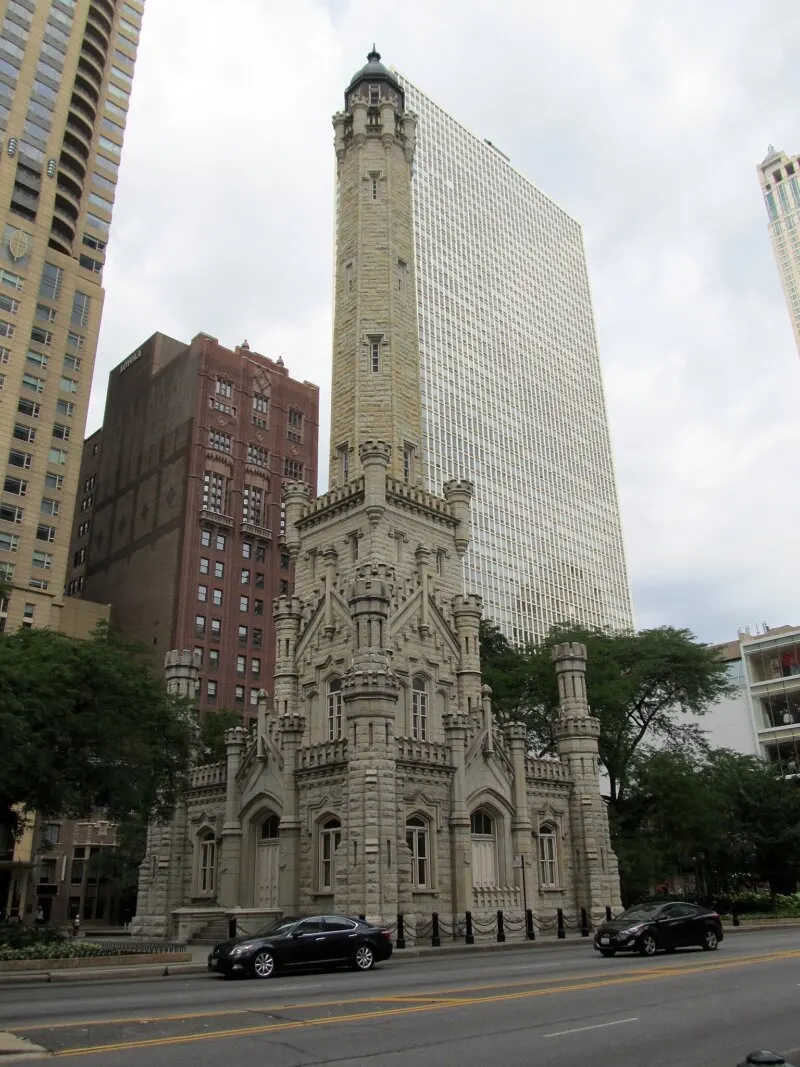 Source / License: daryl_mitchell/CC BY-SA 4.0
Source / License: daryl_mitchell/CC BY-SA 4.0The majestic limestone Chicago Water Tower is a prominent landmark in the city and a testament to perseverance in the face of difficulty. This magnificently rebuilt skyscraper, located close to the Magnificent Mile, is a testimony to Chicago’s history and tenacity.
The magnificent limestone structure of the Chicago Water Tower mesmerizes tourists with its enduring beauty. This old skyscraper mixes perfectly with the nearby urban environment and is between North Wacker Drive and Michigan Avenue.
Its remarkable style is a visual reminder of the city’s impressive architectural talent and extensive history.
The Chicago Water Tower survived the Great Chicago Fire’s devastation, becoming a testament to the city’s resiliency. It serves as a reminder of Chicago’s ability to overcome obstacles and rebuild more powerfully than ever before as the final surviving structure from that era.
The Water Tower was a key component of the city’s water system and was originally called after the Chicago Water Authority. Its historical relevance and significance in the growth of Chicago are highlighted by its role as a crucial component in the early years of the city’s water supply.
You can enjoy them with great relaxation in hotel recommendations here, around the corner from the site.
7. Jane Addams Hull-House Museum
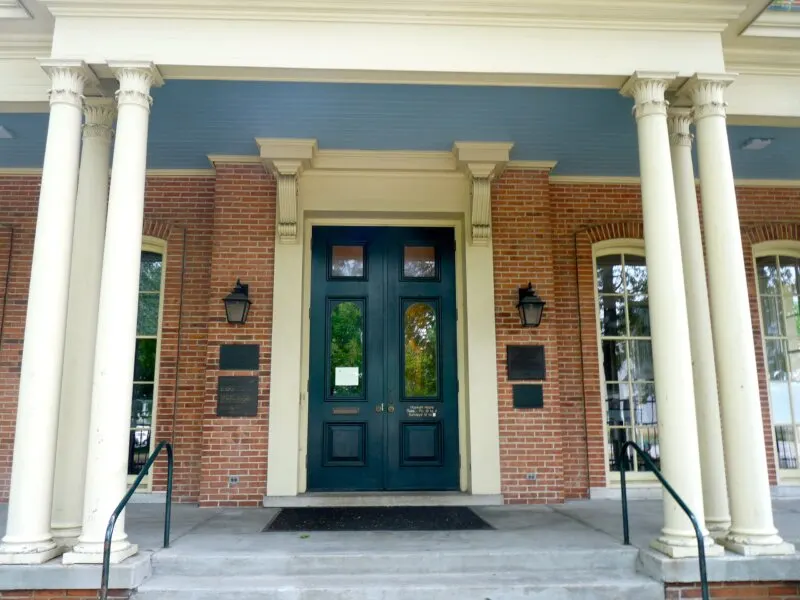 Source / License: Yvphotos/CC BY-SA 3.0
Source / License: Yvphotos/CC BY-SA 3.0Hull-House was established by Jane Addams to give homeless immigrants a place to live. Chicago had an inflow of working-class people looking for better possibilities at the turn of the 19th century. Hull-House developed into a haven where these immigrants could find assistance, training, and resources, enabling them to better their lives and contribute to the city’s development.
Hull-House swiftly transformed into a hub for social change, devoting itself to working-class education and advocating for social reform. It offered educational programs, healthcare services, and social initiatives to close the gap between the rich and the underprivileged.
Hull-House was instrumental in bringing about change by tackling the community’s most pressing problems.
In the College of Architecture, Design, and the Arts at the University of Chicago, Hull-House has a prominent presence today. It is a tangible example of the university’s dedication to interdisciplinary learning, social justice, and community involvement.
Beyond its historical relevance, Hull-House is still significant today, especially in the debates over immigrant rights and worker migration. Hull-House’s museum illuminates the stories of workers and immigrants, promoting understanding and sympathy for current social challenges.
8. Art Institute of Chicago
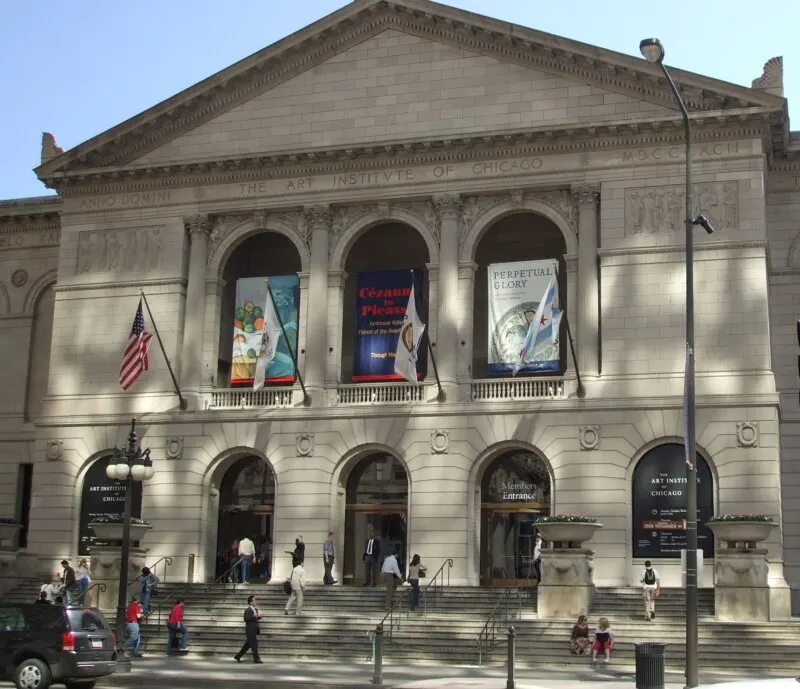 Source / License: Pinotgris/CC BY-SA 3.0
Source / License: Pinotgris/CC BY-SA 3.0Hull-House’s museum illuminates the stories of workers and immigrants, promoting understanding and sympathy for current social challenges.
The Art Institute’s outstanding collection, which spans millennia and includes a wide variety of artistic styles and mediums, is the institution’s center. The museum is home to an extraordinary collection of artworks that attract visitors and offer a look into various ages and cultures, ranging from ancient civilizations to modern masterpieces.
Moreover, it is one of the Chicago downtown Landmarks. Famous works like Grant Wood’s “American Gothic” and Georges Seurat’s “A Sunday on La Grande Jatte” are noteworthy highlights.
The creative riches and the physical presence of the Art Institute are impressive. The museum, housed in a breathtaking structure, expertly combines ancient opulence with contemporary style.
The entrance’s renowned bronze lion statues and beautiful Beaux-Arts architecture have always represented the institution and the city’s cultural landscape.
The museum caters to various groups, from schools to lifelong learners, and offers many educational events and resources. The Art Institute of Chicago encourages a greater understanding and appreciation of art, developing the creative spirit within people of all ages through interactive exhibitions, narrated tours, lectures, seminars, and the School of the Art Institute of Chicago.
You might want to consider great accommodations, and you can also check on nice and budget-friendly tour packages, including the Art Institute of Chicago.
9. Maggie Daley Park
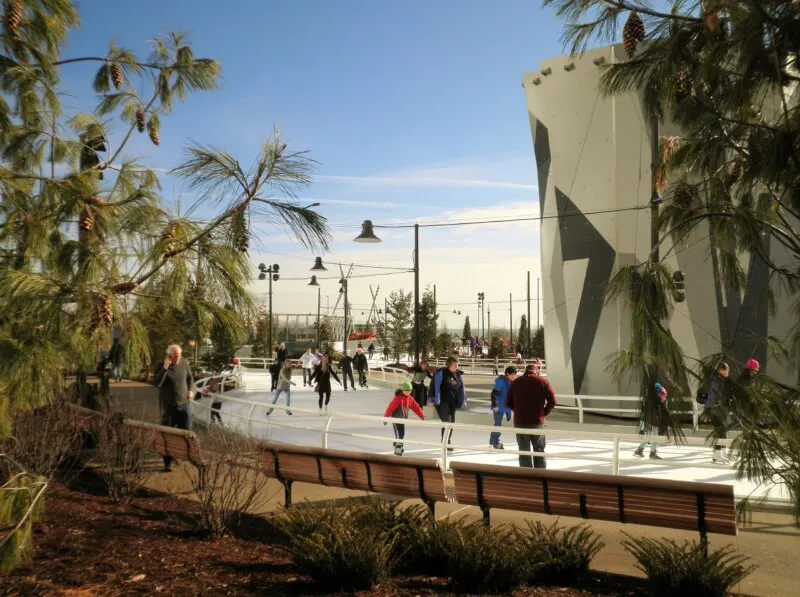 Source / License: Alanscottwalker/CC BY-SA 4.0
Source / License: Alanscottwalker/CC BY-SA 4.0Dedicated to the late Maggie Daley, beloved spouse of former mayor Richard M. Daley, Maggie Daley Park bears her name. The park was created on the former Daley Bicentennial Plaza location to memorialize Maggie Daley’s unwavering dedication to raising Chicagoans’ living standards.
It was developed due to a cooperative effort to turn a hitherto unused area into a lively oasis of amusement and relaxation like Lincoln Park, which is also awe-amusing.
Maggie Daley Park provides an unparalleled selection of recreational opportunities and play areas for visitors of all ages. There are countless options for delight and adventure, from its inventive Play Garden, where kids may explore fanciful buildings and engage in creative play, to the magnificent Skating Ribbon, an amazing ice skating path flowing through the park.
Tennis courts, climbing walls, a mini-golf course, and large open lawns for picnics and relaxation are also available in the park.
The architectural style of the park is both original and eye-catching. An immersive and magical atmosphere is produced by its distinguishing elements, such as the classic Play Garden sculptures inspired by Alice in Wonderland and the unusual design of the Skating Ribbon.
The park smoothly combines contemporary design elements with parts of the natural world, providing a pleasing fusion of urban elegance and tranquil green areas.
10. Willis Tower (formerly Sears Tower)
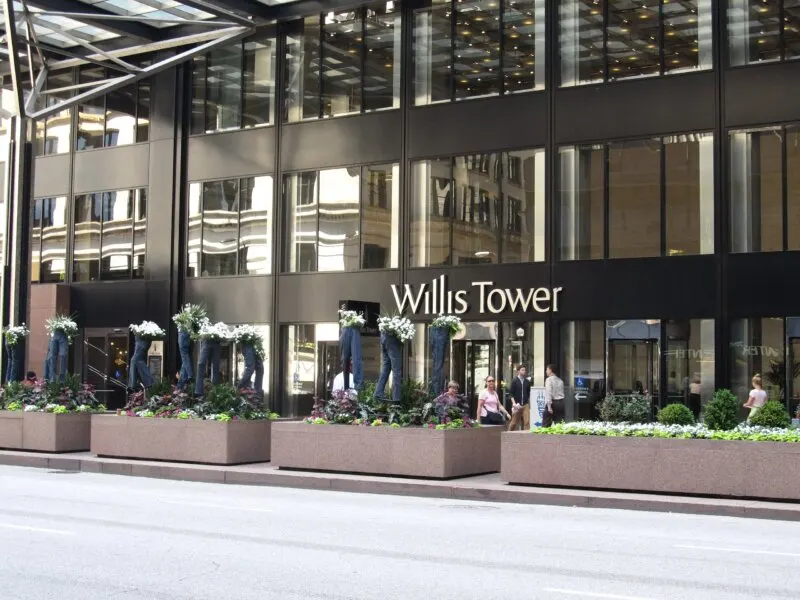 Source / License: Ken Lund f/CC BY-SA 2.0
Source / License: Ken Lund f/CC BY-SA 2.0The history of the Willis Tower began in 1970. The tower, created by engineers Bruce Graham and Fazlur Rahman Khan, was an engineering marvel. At its completion in 1973, it surpassed all previous records for height, symbolizing human ingenuity and breaking the mold for skyscraper design.
The architecture of the Willis Tower is both breathtaking and distinctive. Against the Chicago skyline, its sleek black facade, broken up by several setbacks, has a commanding presence.
The tower’s distinctive bundled-tube structural system, which comprises nine interconnected tubes, provides strength, stability, and flexibility. This system further enhances the tower’s status as an architectural marvel.
The Willis Tower’s renowned Skydeck, which offers guests a spectacular experience high above the city, is one of its most distinctive features. The 103rd-floor glass-enclosed observation deck offers unrestricted panoramic views of Chicago’s expansive surroundings, including the famous Lake Michigan.
For the brave, ascending The Ledge, a set of glass balconies that protrude from the tower’s face is an exhilarating experience that offers a distinctive viewpoint and unrivaled photo opportunities.
You might want to visit more tourist attractions with the best tour package deals, including the Willis Tower. Also, check the nearest hotel attractions that are more convenient for you.
11. Wrigley Field
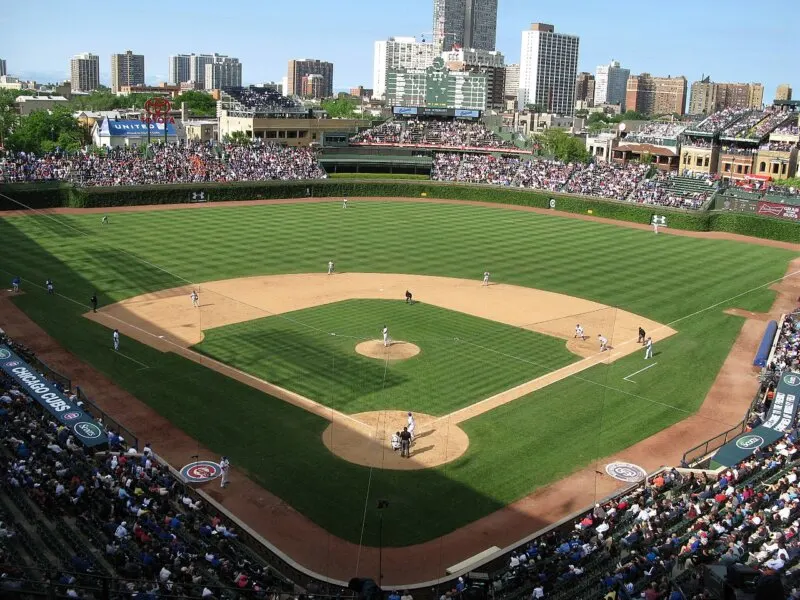 Source / License: Caitriana Nicholson /(CC BY-SA 2.0
Source / License: Caitriana Nicholson /(CC BY-SA 2.0The founding year of Wrigley Field was 1914, the year it opened its doors. Being one of the older stadiums in Major League Baseball, it has seen a century’s worth of significant events, memorable contests, and iconic players.
The stadium has remained a fixture for so long because of its importance as a cultural landmark, solidifying its status as a symbol of Chicago’s sporting history.
The architecture of Wrigley Field is a distinctive fusion of traditional and contemporary styles. Its recognizable red brick facade and ivy-covered outfield walls radiate a vintage charm that calls to mind the pinnacle of baseball.
Wrigley Field stands known for its manually controlled scoreboard, hand-turned outfield bleachers, and the unimpeded view from the rooftops of nearby buildings. These unique characteristics give fans a genuine and unmatched baseball experience.
The influence of Wrigley Field goes beyond the walls of the actual stadium. It has evolved into a representation of Chicago’s undying love of baseball and a focal point for supporters of all eras.
On game days, the Wrigleyville area around the ballpark comes to life as bars, eateries, and street vendors create a lively and celebratory environment. The stadium has a significant cultural impact that draws people worldwide who want to experience the excitement of a Wrigley Field game day.
You might want to explore the nearest hotel in the area for convenience.
12. Lake Michigan
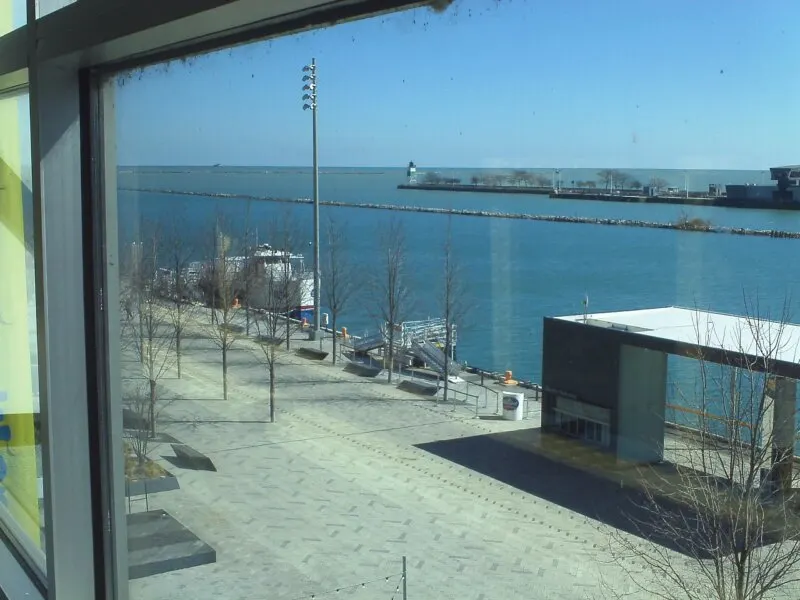 Source / License: DiscoA340/CC BY-SA 4.0
Source / License: DiscoA340/CC BY-SA 4.0Lake Michigan has significantly shaped Chicago’s history and growth. It aided in the city’s expansion and connected it to the rest of the globe by acting as a crucial transportation route for early inhabitants and traders.
The beaches of the lake saw Chicago develop into a thriving metropolis and were crucial to the city’s industrial and cultural development.
The sheer size and magnificence of Lake Michigan are breathtaking. It is the second-largest Great Lake by volume and the fifth-largest lake in the world, covering an area of about 22,400 square miles.
Beyond the horizon, its abyssal size offers tranquility and boundless opportunities that capture the mind.
The shores of Lake Michigan are a refuge for outdoor activity, attracting tourists and locals. Swimmers, sailors, and kayakers are drawn to its crystal-clear waters, providing countless aquatic adventure options.
The sandy beaches, like North Avenue Beach and Oak Street Beach, offer picnicking, beach volleyball, and sunbathing areas. Joggers, cyclists, and strollers are invited to explore the 18-mile lakefront trail and take in the scenic waterfront.
The capacity to display stunning sunsets is one of Lake Michigan’s most alluring qualities. The sky transforms into a canvas of vivid colors as the sun sets, presenting a picture-perfect image that astounds onlookers.
These sunsets are particularly beautiful due to the lake’s size, which also lends an air of serenity and reflection.
Please find out the best tour offers that include Lake Michigan touring; you can check it out here. There are also amazing hotel recommendations that are near your desired destination.
13. Garfield Park Conservatory
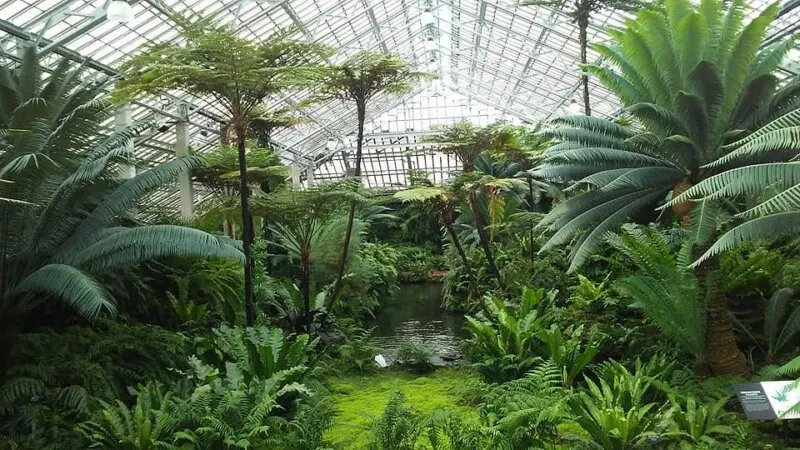 Source / License: TripAdvisor
Source / License: TripAdvisorThe conservatory’s architecture, a stunning example of the Victorian greenhouse style, combines glass and ironwork. The beautiful glass paneled ceilings, elaborate metal frameworks, and detailed details create an aesthetically breathtaking backdrop for the lush plant displays.
The conservatory is a remarkable architectural gem due to its distinctive fusion of historical grandeur and natural beauty.
Visitors can discover an astounding variety of plant species from around the world in the large expanse of the Garfield Park Conservatory. The conservatory spans over 12 acres and has several themed chambers, each highlighting distinct habitats and plant communities.
The conservatory offers a stunning tour of nature’s treasures, from the vivid hues of tropical rainforests to the serenity of desert landscapes.
The Garfield Park Conservatory is a hub for education and is awe-inspiringly beautiful, providing a variety of courses and events for visitors of all ages. Visitors can better understand botany, ecology, and environmental protection through guided tours, interactive exhibits, and hands-on activities.
The conservatory’s commitment to education encourages awe and a love of the natural world.
The conservatory offers a tranquil retreat from the busy city streets and is a beloved communal oasis. Visitors are encouraged to find comfort in nature’s embrace through its perfectly tended gardens, peaceful ponds, and calm walks. It also holds neighborhood gatherings, art installations, and temporary exhibitions, enhancing its status as a center of culture and a destination for locals and tourists.
Related: Best Restaurants in Oak Brook, Illinois
14. Inland Steel Building
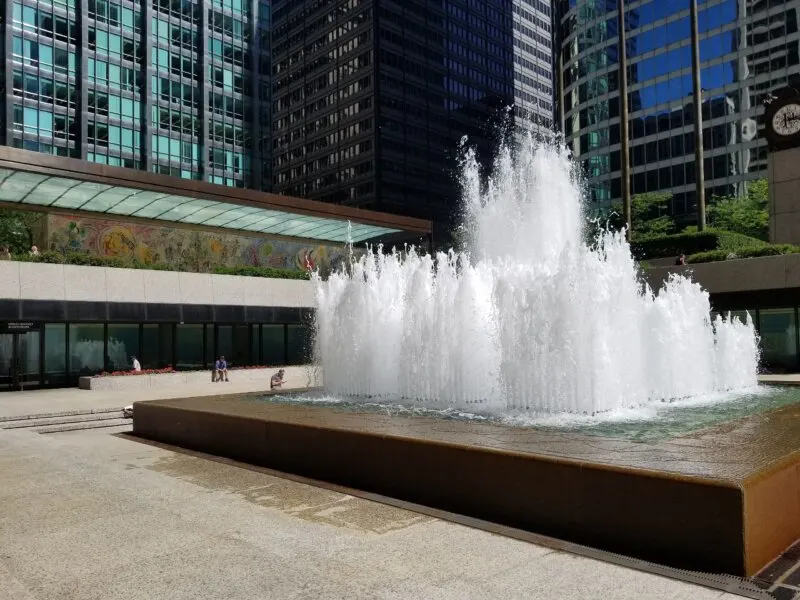 Source / License: SecretName101/CC BY-SA 4.0
Source / License: SecretName101/CC BY-SA 4.0When it was finished in 1958, the Inland Steel Building represented a considerable break from conventional design and arose amid a time of architectural experimentation. Famous architect Skidmore, Owings & Merrill (SOM) envisioned a structure that embraced the International Style’s principles of simplicity, efficiency, and clean lines.
It stood out from its surroundings with its sleek and modern front, which included a curtain wall made of glass and stainless steel.
The Inland Steel Building, which showcased the ingenuity and engineering prowess of the time, embraced the cutting-edge technologies of the day. The steel frame and concrete core of the building’s structural structure allowed for open and flexible interior spaces devoid of blocking columns.
Natural light, transparency, and energy efficiency were harmoniously balanced by the creative use of glass and steel in the curtain wall design.
The Inland Steel Building is a significant piece of Chicago’s architectural history. It is acknowledged as one of the earliest structures in the city to use the International Style, which was significant in influencing American modern architectural movements.
Subsequent skyscrapers were inspired by its daring and avant-garde design, which demonstrated the city’s readiness to welcome innovation in architecture and push the frontiers of design.
The Inland Steel Building has gained notoriety in Chicago beyond its architectural significance. Its unique presence punctuates the skyline and serves as a reminder of the city’s rich architectural history and status as a hub for design and innovation worldwide.
The building’s capacity to mix in with historic and modern surroundings, creating a visual conversation between the past and the present, gives it its enduring appeal.
Related: Best Restaurants in Orland Park, Illinois
15. Kinzie Street Railroad Bridge
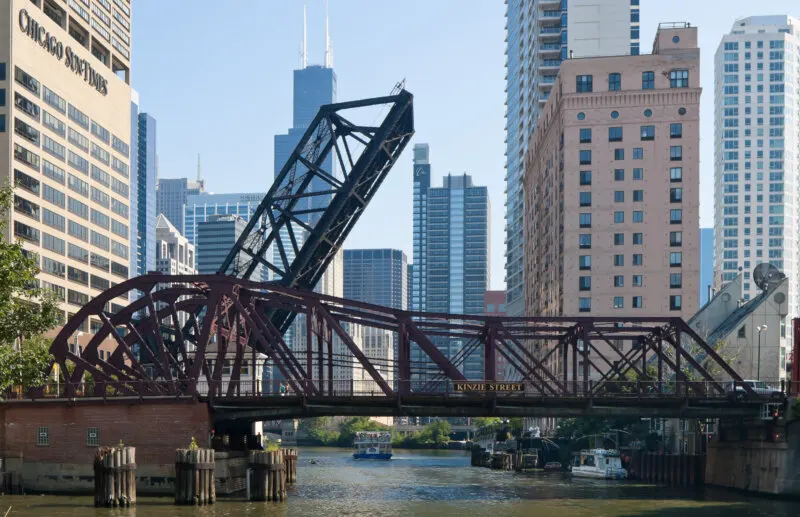 Source / License: User:JeremyA/CC BY-SA 3.0
Source / License: User:JeremyA/CC BY-SA 3.0An interesting history that dates back to the late 19th century may be found on the Kinzie Street Railroad Bridge, which spans the North Branch of the Chicago River. It was built in 1908 to replace an earlier bridge there in the 1850s.
The industrial sectors on the west side of the city and downtown Chicago were connected by this railroad bridge, which was essential for the transit of people and products.
The Kinzie Street Railroad Bridge stands out thanks to its innovative engineering and distinctive design. The bridge is one of the last surviving instances of this style in the United States and has a rare bascule mechanism known as a “trunnion bascule.”
The bridge can revolve on a horizontal axis thanks to the trunnion bascule, raising and lowering the roadway to accommodate river traffic.
The counterweights of the bridge, standing high above the river, provide steady functioning. The enormous steel structure is lifted precisely by a sophisticated system of gears, motors, and cables, allowing ships to pass beneath it.
The Kinzie Street Railroad Bridge is a great example of early 20th-century engineering innovation.
Related: Best Naperville Restaurants to Try
Conclusion
These landmarks provide visitors with an engaging and immersive experience in addition to its historical and cultural value. They offer an opportunity to interact with the city’s vibrant energy, discover its varied neighborhoods, and savor its delectable cuisine.
Chicago offers a fusion of urban sophistication and natural beauty that makes an impression on everyone who visits, from the busy streets of the Magnificent Mile to the serene shores of Lake Michigan.
The city’s must-see attractions are, in essence, the places to see if you want to understand the spirit of the place, delve into its colorful past, and immerse yourself in its dynamic present. They act as entry points into appreciating this amazing city’s significance, history, and distinctive personality.
FAQs
What is Chicago’s famous landmark?
Chicago is famous for many landmarks, but some of the most well-known include:
Willis Tower, The Art Institute of Chicago, Millennium Park, and Navy Pier
What is the most famous part of Chicago?
The Loop is the most famous part of Chicago. It is the central business district and is home to many of the city’s most iconic landmarks, such as the Willis Tower and the Art Institute of Chicago. The Loop is also a major transportation hub, with several train stations and bus stops.
What is Chicago famous for historically?
Chicago is famous for its history as a major transportation hub and industrial center. The city was founded in 1833 at the southern tip of Lake Michigan and quickly became a major port city.
Resources:

